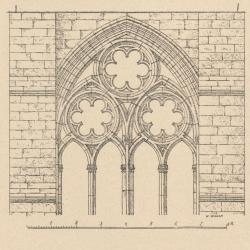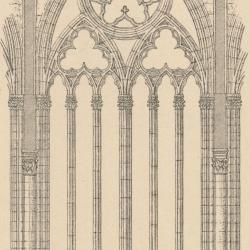Amiens Cathedral
Choir, north flank
To the right, the bishop's palace and above that, the east side of the north transept; to the left, Viollet-le-Duc's winter chapel c.1850.
We see the three straight bays of the choir; great buttresses rise to form the uprights (culées) of flying butresses. Chapels were never added in the choir, so the projecting buttresses form emphatic bay divisions so unlike the smooth outer walls of the nave chapels. In the lowest level of the wall you can see two blocked doorways--they once led to the two-story treasury that housed the head of John Baptist (see the engraving below). This ancillary structure once blocked the lower part of two of the windows: when it was demolished c 1750 the windows were opened up to admit more light. The enclosing arches of the aisle windows are not as steeply pointed as in the nave and instead of a single great oculus there are three smaller oculi of equal size.
Above the level of the aisle roof we see a sharp change. The simple flat-sided buttresses turn into more delicately articulated uprights; the flying buttresses have openwork tracery panels; the clerestory tracery is more complicated with triple lancets paired under a great oculus, and the upper roof line is punctuated with gables.


